
Technology
Hardware & glazing systems
Innovations: Open Future
Entrance systems continue to advance in every area.
February 23, 2010 By Mike Davey
In a very real way, humanity still lives and works in caves. The caves
today are much more comfortable and better lit – and they certainly
smell better – but the central idea, that of separating the inside from
the outside, remains the same.
In a very real way, humanity still lives and works in caves. The caves today are much more comfortable and better lit – and they certainly smell better – but the central idea, that of separating the inside from the outside, remains the same. A key factor in that separation is the entrance system.
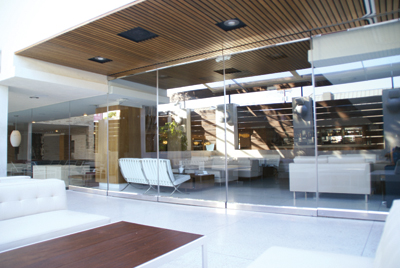 |
| More and more, retail and restaurant customers are demanding an “open space” approach to their experience, and businesses are often happy to oblige, including AREA Nightclub in Los Angeles (right), which installed the SPS doors from C.R. Laurence. Photo appears courtesy of CRL.
|
Modern entrance systems are obviously very far removed from the days when humanity would shut out the night and the cold with a tent flap, or in the case of more permanent dwellings, a rectangle of wood. However, what is not so obvious is how far removed the entrance systems of today are from their predecessors of just a few years ago. This gap will continue to widen. The entrance systems of the future will be “smart”, able not only to perceive, but to make judgments. By 2020, we may be living in a world where entrance systems not only open automatically, but also prevent entry when it’s deemed necessary.
“In terms of security, since 9-11 we’ve seen a lot more interest in entrance control,” says Don Hussey, a senior territory manager for Stanley Canada. “Also, LEED standards have meant that more and more people are really pushing for advanced entrance systems. Simply put, doors are the most porous part of the building.”
Donnie Hunter is Kawneer’s product manager for storefronts, entrances and framing. He points to increasing environmental – and economic – awareness as a primary driver for advancement in entrance systems.
| Future Materials
Technological advances in material sciences have always had an effect on our buildings and the way we interact with them. Our current scientific know-how and technological capabilities allow us to achieve incredible things. However, the most incredible things are still to come. Today we can make glass that resists impacts better than ever before. Once it breaks, though, it’s broken. It’s hard to view this as a failing, but only in light of today’s technology. Glass entrance systems of the future will not only be even more shatter resistant, but keeping a close eye on materials science suggests that they will actually heal once scratched or broken. Materials that can perform these feats already exist; however, they’re generally so expensive to produce that no one uses them. An announcement last year regarding automotive paint that can heal its own scratches shows that this is starting to change. You may have heard of the carbon nanotube, which has amazing properties because of its molecular structure. Manufacturing these is currently painstaking and expensive. Once these barriers are overcome, carbon nanotubes will literally change everything. Carbon nanotubes are only one small example of the many amazing materials currently being developed. When the subject turns to things like metamaterials, which have the theoretical capability of bending any part of the electromagnetic spectrum, it becomes apparent that the future will be a very strange and exciting place to live. |
“Over the last few years there has been an increased emphasis on improving the energy efficiency and thermal performance of a building,” says Hunter. “As a result, we have seen the development of doors that are truly thermally broken, versus the cladding approach to achieve thermal performance.”
Hunter also notes that a perceived need for increased security has helped drive advancement.
“The availability and increased use of access hardware is another advancement to entrance systems,” says Hunter. “The security of buildings and the occupants has become ever more important. To gain entry, increasing interest and use of hardware such as slimmer automatic operators, availability and style of card readers, key pads, bio-scripts is requested daily.”
There is some credence to the idea that automatic entrance systems will become the standard. Peter Zagar of Commdoor Aluminum thinks so, and his reasoning is based on a solid foundation.
“It will become so affordable that there won’t be any reason not to go with automated entrance systems,” says Zagar. As noted above, the entrance system is the most porous part of the building. Air comes in, and air goes out. It simply makes sense to have as much control of this as possible, assuming that it can be done affordably.
However, many automatic entrance systems simply aren’t very selective, and open at inappropriate times. The future may bring changes to this as well.
“I think we’ll start to see systems that are better at gauging intent to enter,” says Zagar. “Currently, if the system senses anything – anything at all – it will open. You don’t want that. We want the door to open only when someone wants it to open. Glass has come a long way. Why not develop a kind of glass that’s sensitive to temperature or pressure? Place your hand on the door, and it slides open.”
That future may not be very far off. In fact, it will be surprising if it isn’t ready to market in a few years at most. Incredible advances are made daily in both materials science and near nano-scale electronic components. Given those factors, we’re almost certain to witness increasing levels of automation in entrance systems.
Paul Daniels is the VP of sales and marketing for C.R. Laurence. He notes that we’re already seeing increased automation, especially in the area of stackable door systems.
“People want more open spaces, especially in retail. If you can get a door or a wall to totally disappear, that solves some of their problems,” says Daniels.
The maximization of open space is certainly gaining acceptance in the retail and restaurant sector, where bi-fold glass doors and windows are becoming more common. In restaurants, for example, a bi-fold glass door or window can be used to bring the outside indoors.
“We’ve seen it, but mostly in the United States,” says Peter Zagar of Commdoor Aluminum. He believes we may be seeing more of it in Canada in the near future “We’ve been getting a lot of inquiries about those systems, so we’re definitely looking into it. The advantages are obvious. For a retailer, it’s better if your customers can walk in unimpeded.”
Don Hussey notes that automated entrance systems have not only become mainstream, but almost mandatory in some situations.
“The advent of the big box retailer has been the biggest story,” says Hussey. “When we go to a large retailer, we don’t expect to have to open the door manually. Customer service elements have really brought forth this advancement.”
While customer service may be at the heart of the increasing number of automatic entrance systems currently in use, Steve Petersen of Automatic Entrances notes that it isn’t the only factor driving it.
“Automatic sliding doors are intrinsically safer, because of advanced sensors and programming,” says Petersen. “They used to be fairly rare, but it’s becoming part of the building code. Any store that has over 5000 square feet for public use has to have Barrier Free Door Operators, and I wouldn’t be surprised to see that dropped to 3000 square feet. If you’ve got public washrooms, you’ll probably have to have one for there as well.”
Petersen also notes that, considering North America’s aging population, automatic entrances are very likely to proliferate.
Moving past automatic systems, there are a number of trends that we can expect to see develop further.
“Some of the trends we’re seeing now are more curved glass for entrance systems and more combination products, for example a door closer that’s also part of the door rail. We’re likely to see more of those things as customers become more demanding,” says Daniels of CRL. “Combination products also make for easier installation, because it gives you more functions right on the door.”
As time goes on, it seems consumers want more and more from their products. This also applies to entrance systems. Where once a customer might have been satisfied with a door that is 75 per cent glass and 25 per cent aluminum, they now want a door that is almost entirely glass.
“People want more glass, and less metal,” says Daniels. “People want wider, higher glass doors, with more vision through the door. That’s the first factor. The second is the onslaught of hardware designed especially for all-glass entrance systems. From handles and hinges, to pivot and header systems, there’s simply a lot more available than there used to be.”
Discussing variety in hardware also strikes a chord with Donnie Hunter of Kawneer.
“Aesthetically, we have gone from a bulky look, to a sleeker look, to the all glass look, and back to the more bulky look,” says Hunter. “Functionally, changes have occurred due to the many code requirements such as ADA, hurricane resistance and blast mitigation. Additionally, hardware options have improved over time. Years ago it seemed there were only one or two manufacturers that made quality high-end door hardware; today many companies offer a wider variety of quality hardware lines.”
Product Showcase
As part of our coverage of entrance systems, Glass Canada magazine has reached out to a number of different manufacturers for information on the latest and greatest. All information is presented alphabetically by company. Inclusion in this section does not constitute an endorsement of any kind by Glass Canada magazine or its staff.
C.R. Laurence Stacking Partition System
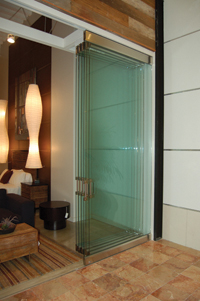
|
|
|
|
The C.R. Laurence (CRL) Stacking Partition System (SPS) featuring Intelli-Track has recently been improved to include convertible sliding and pivoting doors. CRL says that you can now have what appears to be a standard “all-glass” entry with pivoting doors that can be quickly and easily converted to sliding stacking panels. The panels can park out of the way, leaving you with a wide-open entrance.
According to CRL, the SPS System has been designed to provide virtually unlimited possibilities in the design of moveable glass dividing walls. It offers standard pivoting doors with full sliding and stacking capabilities. This allows for accessibility control, while still allowing the option to easily open up any space when needed. CRL says they’re ideal for storefronts and malls, allowing full visibility of merchandise, combined with the flexibility to be stored conveniently out of the way. Restaurants, sidewalk cafés, and nightclubs can easily expand their indoor/outdoor seating space.
The system features bottom rails with fully concealed closers inside. According to CRL, this eliminates unsightly floor closers, while keeping all of their features and benefits. No obtrusive headers found here, just a simple gearbox at the head, which allows you to convert from swinging to sliding doors and back again with the turn of a single screw.
SPS utilizes CRL’s patented Wedge-Lock Glass Securing System found in its popular Door Rails. A variety of rail configurations, functionalities and finishes are available.
Dawson Doors Dawson Custom Series
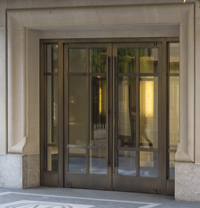
|
|
|
|
The Dawson Custom Series incorporates a one-piece metal skin welded to a continuous metal frame structure. According to Dawson Doors, the result is a truly seamless door face with a flawless superior finish. The company says it will satisfy the most exacting specifications with enhanced swing function, suppressed sound transmission and durable construction.
The series is available in 13-, 14- or 16-gauge thickness or as specified. Features include adjustable head and sill weatherstripping without exposed fasteners; interior glazing stops; screw-applied or pocket glazing using no exposed fasteners,; and custom size to match design. Grilles, muntins, extrusions and castings are available to meet design requirements. The Custom Series comes in many different finishes, including #4 satin, #6 satin, #8 polished mirror, or non-directional
(angel hair).
The stainless steel for Custom Series doors is AISI Type 304 or 316 with 13-, 14- or 16-gauge frames and doors. Bronze for all doors is CDA Alloy 464 with a minimum thickness of .090” on frames and .060” on doors. Other metals are available as well. Please consult Dawson Doors for details.
Dorma Glass MAGNEO
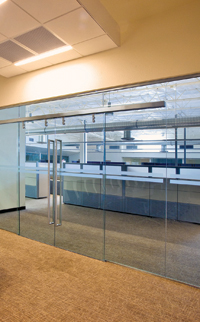
|
|
The MAGNEO sliding door system from Dorma Entrance Systems (www.dorma-usa.com), powered by advanced linear magnetic drive technology (LMD), opens and closes doors with an even gliding action that’s virtually free of sound and friction.
To complement the smooth movement, the MAGNEO system’s clean lines and unobtrusive, low-profile header blend into commercial or residential settings, especially those with a modern or minimalist design motif.
According to the company, it is the only sliding door entrance system to utilize LMD technology instead of belts, pulleys, gears or motors. The unparalleled MAGNEO system enables a sliding door to open and close on an electromagnetic “cushion,” reducing wear, noise and maintenance.
In addition, MAGNEO can be used in “green” applications. The use of glass doors can improve interior daylighting properties. Meanwhile, it uses less energy than a 60-watt light bulb during operation and a mere tenth of that when inactive.
MAGNEO is also engineered to meeting all safety requirements for low-energy applications. The company says its extra-sensitive operation instantly detects any obstruction and reverses the closing operation to prevent potential injury.
The versatile MAGNEO system can be configured with either a recessed door grip or stylish minimalist handle when used with all-glass doors. A glass clamping rail is available for added stability. Various activation options are offered: motion detector, radio remote control, external program switch, and push-and-go operation.
International Revolving Door Phoenix APB High Security
According to International Revolving Door, an attitude of “security first” has made Phoenix one of the world’s most secure revolving doors. There are essentially four violations that can occur in a quadrant:
- Tailgater attempting building entry
- Tailgater attempting Building exit
- Piggybacker attempting building entry
- Piggybacker attempting building exit
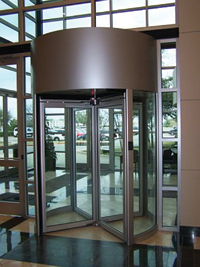
|
|
A tailgate occurs any time a person enters an unapproved quadrant. The Phoenix APB program continually monitors for tailgating, whether the door is idle or in cycle. For example, if this occurs on the exterior of the building, it would be a “Tailgater attempting building entry” violation, and security would receive this signal.
A piggyback occurs when a second person attempts to enter an approved quadrant. The program monitors for piggyback during the first 85 degrees of a 180-degree Entry or Exit cycle.
Normally the Phoenix Security Door is set up as a two-way security door (controlled access for both sides of the door). However, the door can be set up to operate as a one-way security door. With the addition of an optional switch, the door can be switched from one-way security to two-way security at any time. With the addition of an optional 24-hour timer, the door can be set up to switch between one-way and two-way security at set times of the day. The door can also be set up to operate without any security.
Night Operation is where the door is set up as a standard two-way security door (controlled access for both sides of the door). Day Operation is where the door operates without any security (uncontrolled access from both sides). In Day Operation mode, the door is basically a standard automatic revolving door. With the addition of an optional switch, the door can be switched from Day Operation (no security) to Night Operation (full two-way security) at any time. With the addition of an optional 24-hour timer, the door can be set up to switch Day and Night Operation at set times of the day. The door can also be set up to operate with one-way security.
International Revolving Door can build your door to your individual specification requirement. Customers can choose between Stainless Steel Brushed, Stainless Steel Mirror, Bronze Clad, Bronze Cast, Anodized and Painted Aluminum finishes.
Kawneer AA 3200 SOWEB Sliding Door
The effects of weather are major considerations when designing and constructing buildings. According to Kawneer, the AA 3200 ISOWEB Sliding Door is designed to meet the challenges of thermal, coastal and hurricane-resistant conditions.
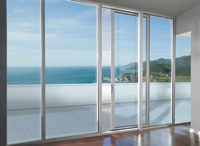
|
|
|
|
With contemporary hardware, clean sightlines, sound resistance and endless configuration options, Kawneer says the AA 3200 ISOWEB Sliding Door is the perfect choice for your next high-end project. Balancing form with function, this sliding door stands up to the elements.
High-velocity winds, torrential rains, blizzards and hurricanes are just a few of the challenging weather elements that architects and building owners face. Kawneer’s AA 3200 ISOWEB Sliding Door, designed to meet thermal, coastal and hurricane resistant conditions, helps meet these challenges. Available in both High Performance (HP) and Hurricane Resistant (HR) versions, the AA 3200 ISOWEB Sliding Door complements Kawneer’s portfolio of thermal solutions and products for the entire building.
Kawneer’s high-performance ISOWEB thermal break allows this slider to meet current energy codes and provides capabilities for a dual finished product. In addition to thermal performance, AA3200 ISOWEB Sliding Door has been tested for both large and small missile impact on panels up to 10 feet tall. For enhanced STC and OITC (sound resistance) performance, the slider accommodates 1-5/16-inch insulated/ laminated glass, and it accommodates one-inch insulated glass for improved thermal performance.
A larger wheel, stainless steel tandem roller with precision ground sealed bearings provides smooth operation on even the largest and heaviest sliding panels. Additionally, the sealed bearings offer maximum protection against coastal elements such as wind-blown sand and salt water. Other features include corrosion-resistant stainless steel locks and fasteners. To keep insects at bay, interior insect screens are available.
AA3200 ISOWEB Sliding Door can span slab-to-slab up to 10 feet tall, which offers occupants clear, unobstructed views. Various mullion and reinforcement options provide additional performance and design flexibility. Permanodic Anodized finishes are available in Class I and Class II in seven different colour choices.
Painted finishes, including fluoropolymer, that meet AAMA 2605 are offered in many standard choices and an unlimited number of specially designed colours. Solvent-free powder coatings add the green element with high performance, durability and scratch resistance that meet the standards of AAMA 2604.
Kohltech Windows & Entrance Systems Tilt & Turn Patio Door
According to Kohltech Windows & Entrance Systems, the company’s Tilt & Turn Patio Door is a unique offering, and gives new meaning to the words functionality and flexibility. It combines the functions of a door and a window, without giving up anything in either application.
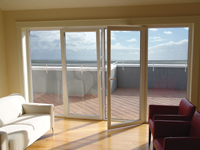
|
|
|
|
In the upright position, the Tilt & Turn functions as a traditional in-swing patio door providing easy entrance and exit. Don’t be fooled, though, as the Tilt & Turn Patio Door is anything but traditional. In the tilt position, the entire door gently tilts inward. This helps to provide both air circulation and cross ventilation without compromising security. A single handle conveniently operates both the tilt and turn functions.
Kohltech Windows & Entrance Systems is based in Debert, Nova Scotia, Canada. Since its inception in 1978, the company has grown from four employees to several hundred. Peter Kohler Windows & Entrance Systems manufactures vinyl and wood-vinyl windows as well as steel and fibreglass entrance systems under the Kohltech Windows brand in the USA, the Peter Kohler Windows brand in Eastern Canada, Quebec and Ontario and the Equibilt by Kohltech Windows & Entrance Systems brand in Western Canada. Peter Kohler products are manufactured to the highest ISO 9001 standards.
NABCO I GT 175 Whisper Slider Series
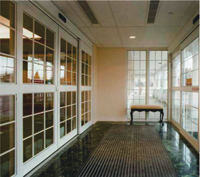
|
|
|
|
According to NABCO, the GT 1175 Whisper Slider Series sets the standard for smooth operation and quiet “whisper-like” performance. Designed for challenging conditions, the company says that wind, rain, snow and now even hurricanes, are no match for the rugged GT 1175 Whisper Slider Series. Microprocessor control provides reliable door operation, important usage counts, and diagnostic features for quick trouble-shooting and reduced maintenance costs. These fully automated entrance systems include doors, jambs, operators and sensors, all manufactured by NABCO Entrances for seamless integration and easy maintenance.
The GT 1175 Series is available in two standard anodized finishes: clear aluminum or dark bronze. NABCO can provide a customer colour match in wet paint or powder coat paint. Custom anodized colours are also available.
The standard sensor configuration of the GT 1175 Series comes with two header-mounted Acusensor 1B units and one holding beam for efficient, safe and reliable door operation. Acusensor 1B provides a grid-like rectangular detection pattern that allows you to choose multiple width and depth coverage for detection patterns more closely suited to your specific application. Acusensor 1B continually operates at full power. This means full-time detection, even during opening and closing cycles.
The GT1175 Whisper Slider Series also comes with a number of optional sensors.
Acumotion combines two technologies for more effective pedestrian detection. NABCO’s state-of-the-art Microwave Motion technology provides a wider activation zone for moving objects. Infrared Sensors detect both moving and stationary objects within the threshold area. NABCO says that together they provide the deepest detection area available in a single presence-sensing unit.
The Acuvision Learning Sensor System provides enhanced presence sensing coverage to include the entire threshold area and moving path of the door. This ability to memorize the slide or swing path of the door allows for extended coverage.
The Acuwave “Touchless” sensor responds to a voluntary hand motion within the detection area. It is the ideal solution for heavy pedestrian-cross traffic areas such as sidewalks or hallways and for “hands-free” environments such as restrooms, health-care facilities and clean rooms. The Acuwave will help prevent unnecessary door opening cycles, keeping conditioned air inside your facility and saving energy.
U.S. Aluminum Series 900 Terrace Door
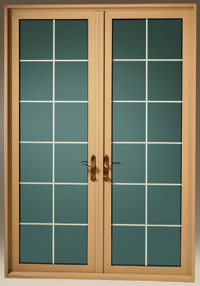
|
|
|
|
The Series 900 is a high performance door for use in condominiums, lofts, hotels and high-rise apartments. According to U.S. Aluminum, the Series 900 Terrace door will withstand heavy traffic and the worst of weather conditions while maintaining its elegant styling. The 21/4" thick door with a 1" x 41/2" frame features double polyamide glass reinforced strips providing superior interior to exterior thermal separation. For maximum security, the Series 900 includes a seven point locking device for pairs and five point device for singles. Three, five knuckle hinges with non-removable stainless steel pins per leaf complete the sturdy look and feel of the Series 900 Terrace Door.
The Series 900 Terrace Door accepts one-inch insulated glass, and comes in three hardware styles with 12 finish options. It’s available as an in-swing or out-swing, and in a painted or anodized finish. Features include a seven point locking device for pairs, and a five point device for singles. The entrance system is thermally broken. •
Print this page